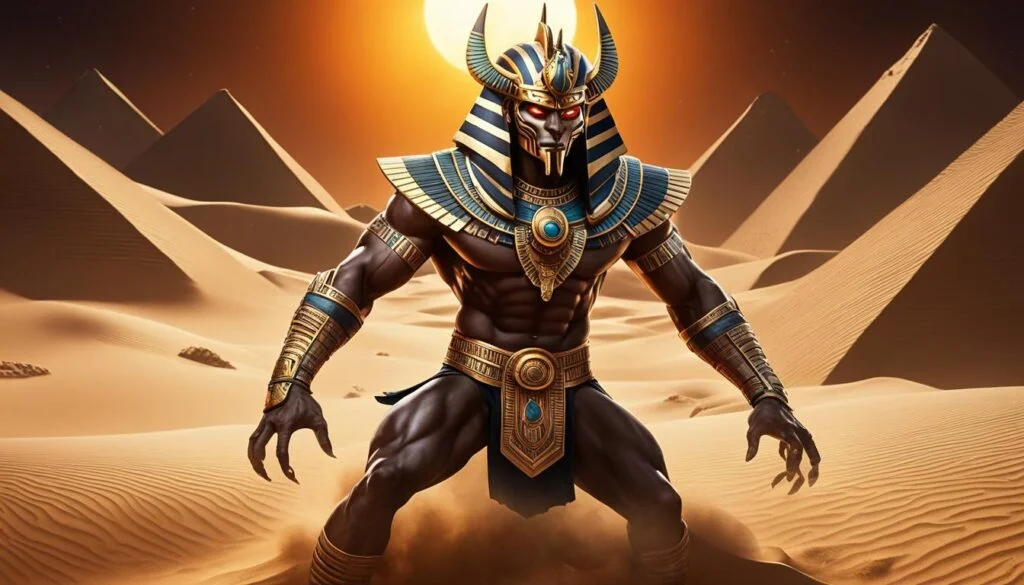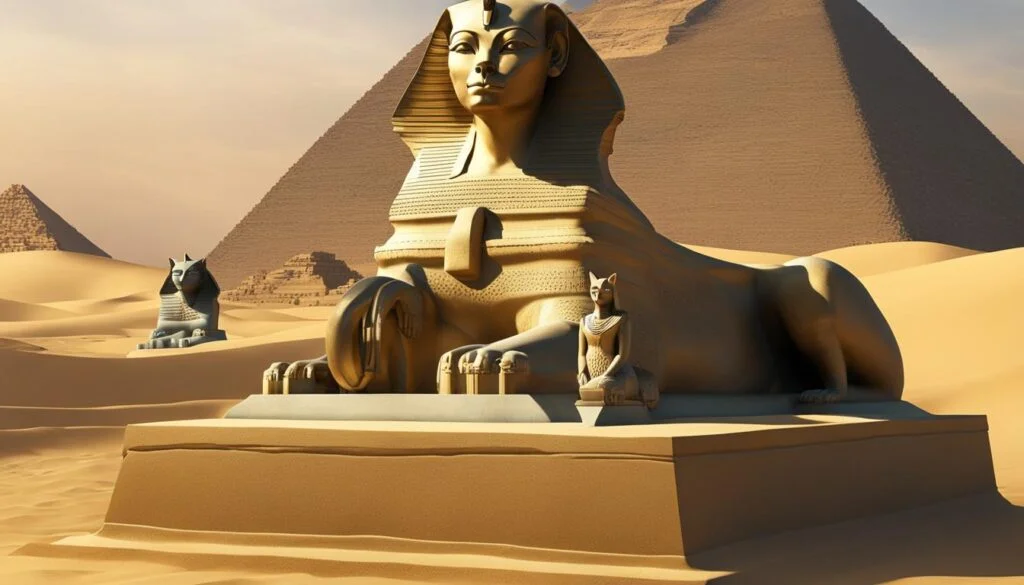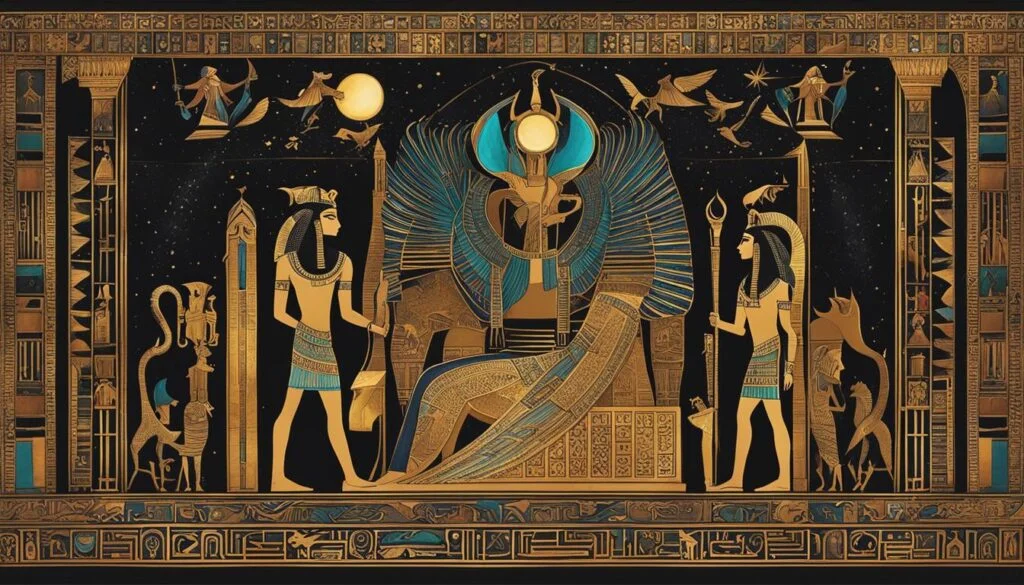In Egyptian mythology, Seth is a fascinating and enigmatic figure who holds significant power as the god of chaos. His complex relationships with other deities, particularly his brother Osiris and nephew Horus, have shaped the mythological narratives of ancient Egypt.
Through the study of Egyptian texts and artifacts, we can uncover the symbolism, stories, and fascinating facts surrounding Seth’s role in the Egyptian pantheon.
In Egyptian mythology, Seth, the god of chaos, plays a complex and crucial role. He embodies necessary disruption and storms, balancing the cosmic order alongside his sister Nephthys, goddess of mourning and transition. Their intertwined stories explore themes of chaos, order, loyalty, and transformation, offering captivating insights into ancient Egyptian beliefs and the delicate equilibrium of life and death.
Key Takeaways:
- Seth is a prominent god in Egyptian mythology known for his association with chaos.
- He plays a crucial role in the stories of Osiris and Horus, his brother and nephew, respectively.
- Seth’s symbolism and iconography reflect his dual nature as a disruptor and creator of storms.
- He is an essential character in maintaining the cosmic balance in the Egyptian pantheon.
- Studying Seth provides insights into the belief systems and ancient Egyptian culture.
The Enigmatic Pair: Seth and Nephthys in Egyptian Mythology
Seth and Nephthys form an enigmatic duo in Egyptian mythology. As siblings and spouses, their contrasting personas of chaos and mourning interlink and affect the cosmic balance in ancient Egyptian beliefs.
Unraveling their intertwined tales of power, deceit, and love allows us to better understand the complexities of the Egyptian pantheon and the balance between order and chaos.
In the intricate tapestry of Egyptian mythology, Seth and Nephthys occupy unique roles that shape the cosmic equilibrium.
Seth, the god of chaos and storms, stands as a force of disruption, while Nephthys, the goddess of mourning, offers solace and guidance to those embracing the transition from life to death.
Their relationship, both as siblings and spouses, presents a duality that reflects the very essence of existence – the interplay between order and chaos, creation and destruction.
Seth’s chaotic nature is tempered by Nephthys’ nurturing presence, symbolizing the delicate balance required for the cosmos to retain its harmony.
Mythological narratives highlight the intertwined fate of Seth and Nephthys, revealing a complexity that transcends mere deities.
Through tales of loyalty, betrayal, and emotional trials, their relationship mirrors the human experience and the perpetual struggle to forge equilibrium amidst life’s uncertainties.
Delving into the mythology surrounding Seth and Nephthys opens a gateway to understanding the profound intricacies of the Egyptian pantheon.
It grants us insight into how their stories and symbolism serve as a reflection of the cosmos and the eternal dance between cosmic forces.
Join us as we journey into the enigmatic world of Seth and Nephthys, exploring their cosmic impact, their intricate relationship, and the spiritual lessons hidden within their mythological narratives.
The Role of Seth and Nephthys in the Egyptian Pantheon
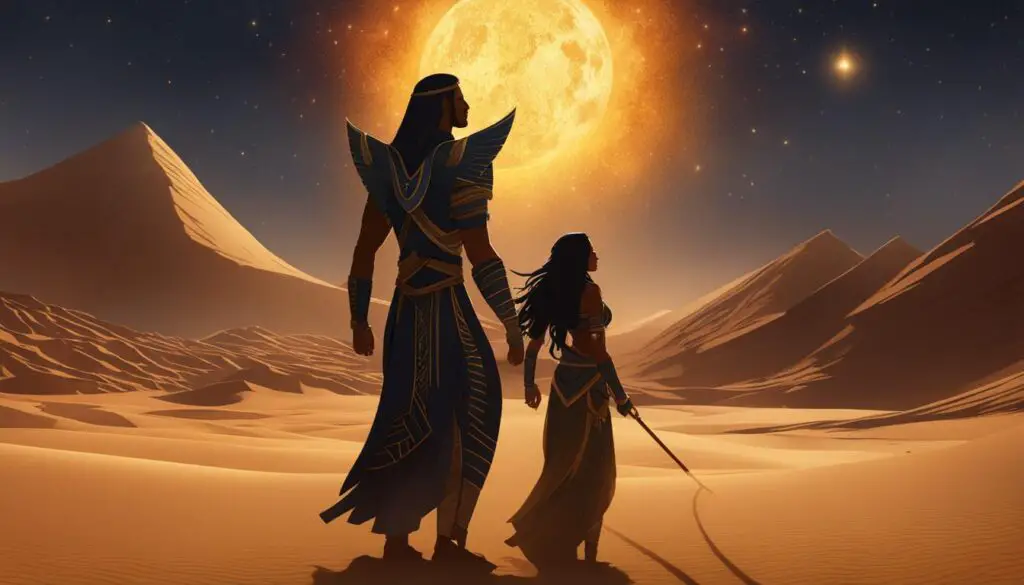
Seth and Nephthys, two prominent figures in Egyptian mythology, played crucial roles in maintaining cosmic harmony and order within the Egyptian pantheon.
Their divine positions and contributions were essential in upholding the delicate balance known as Ma’at.
Seth’s Role in the Egyptian Pantheon
In the Egyptian pantheon, Seth held the title of the Lord of the Desert and embodied chaos and storms. Despite his disruptive nature, Seth’s role was not merely destructive.
Instead, his chaotic forces were necessary for the renewal and vitality of the Egyptian world. Seth’s divine essence allowed for the transformation and rebirth that were vital to the cycle of life.
Nephthys’ Role in the Egyptian Pantheon
On the other hand, Nephthys served as the guardian during the transition from life to death. As such, she ensured the safe passage of souls into the afterlife.
Nephthys played a crucial role in guiding and protecting the deceased, providing solace and comfort during this transformative journey.
Together, Seth and Nephthys represented the contrasting forces of chaos and transition, which were essential for maintaining cosmic order.
Their divine roles emphasized the interconnectedness of life and death, chaos and order, and the perpetual cycle of creation and renewal.
The Origins and Significance of Seth
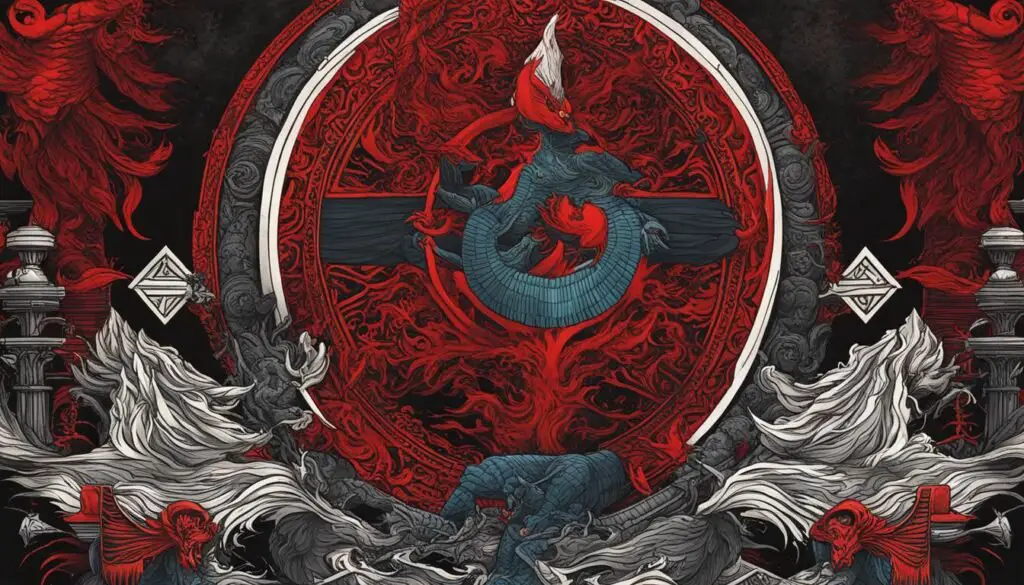
Seth, the enigmatic god of chaos and storms in Egyptian mythology, holds immense significance within the ancient pantheon.
While the origins of Seth remain shrouded in mystery, his multi-layered symbolism and iconography reflect his dual nature as both a disruptor and a protector.
One of Seth’s notable roles is that of the protector of the powerful sun god Ra, safeguarding him from the treacherous serpent Apep in his nightly journey through the underworld.
This highlights Seth’s importance in upholding the cosmic balance and order, as chaos and storms play a vital role in the renewal and vitality of the Egyptian world.
Seth’s symbolism is reflected in various artistic depictions, often featuring a Canid-like head that signifies his connection with the wilderness and the untamed forces of nature.
His presence as a necessary disruptor serves as a reminder of the trials and challenges that lead to resilience and growth.
As we delve deeper into the enigma of Seth, we unravel the intricate layers of his significance, from his pivotal role as the protector of Ra to his representation of chaos and storms.
He embodies the delicate balance between disruption and protection, highlighting the transformative power of storms and the vital role they play in the eternal cycle of creation and renewal.
Nephthys: The Protective Goddess of Mourning
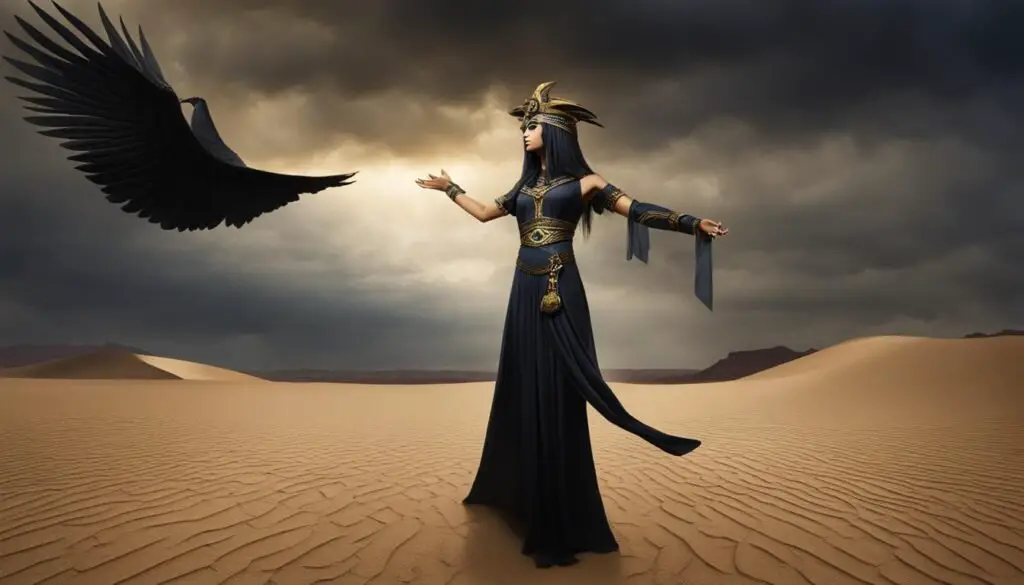
In the rich tapestry of Egyptian mythology, Nephthys emerges as an often overlooked figure, overshadowed by her more renowned siblings.
Yet, her role as the protective goddess of mourning highlights her crucial significance in the ancient Egyptian belief system.
During the arduous journey to the afterlife, Nephthys offered solace and comfort to the deceased. As a guardian and guide, she nurtured their souls, ensuring a smooth transition from the mortal realm to the divine.
Her presence was essential in easing the passage and providing the necessary support during this transformative process.
Nephthys’ association with funerary rites elevated her importance further. She actively participated in the rituals that honored the departed, ensuring that they were appropriately prepared for the afterlife.
Her deep connection with the dead entrenched her as a vital link between the mortal and divine realms.
The Union of Seth and Nephthys
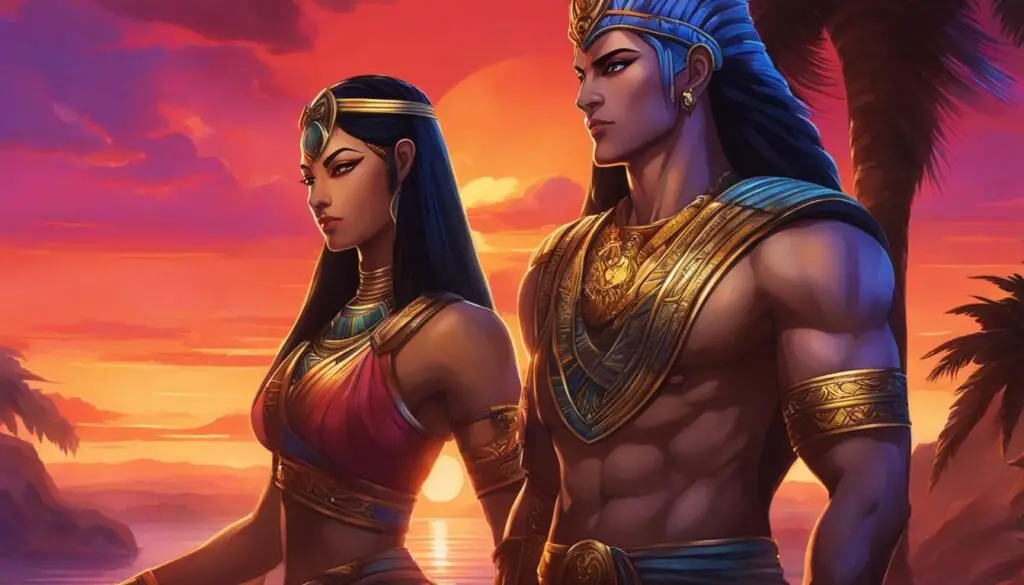
The marriage between Seth and Nephthys was not only a mythic coupling but also a political alliance within the divine realm.
Their union represented the extremes of the Egyptian pantheon, with Seth embodying chaos and Nephthys providing nurturing guidance.
Nephthys’ loyalty was constantly tested between her husband Seth and her sister Isis, showcasing the complex relationships and emotional trials faced within Egyptian mythology.
As an unlikely pair, Seth and Nephthys formed a powerful alliance that reflected the intricate nature of divine politics.
Seth, the god of chaos, and Nephthys, the goddess of mourning, came together in a cosmic union that brought together opposing forces.
While Seth represented disruption and unpredictability, Nephthys provided solace and stability, balancing the chaos. Their marriage not only symbolized the merging of these contrasting energies but also served as a strategic alliance to maintain order within the Egyptian pantheon.
Despite their complex relationship, Nephthys remained loyal to Seth, even in the face of temptation from her sister, Isis.
Her unwavering commitment highlighted the intricate dynamics and emotional challenges faced by the gods and goddesses of ancient Egypt.
Through the union of Seth and Nephthys, Egyptian mythology acknowledges the delicate balance between chaos and order, emphasizing the importance of collaboration in navigating the intricate web of divine relationships.
Key Myths Involving Seth and Nephthys
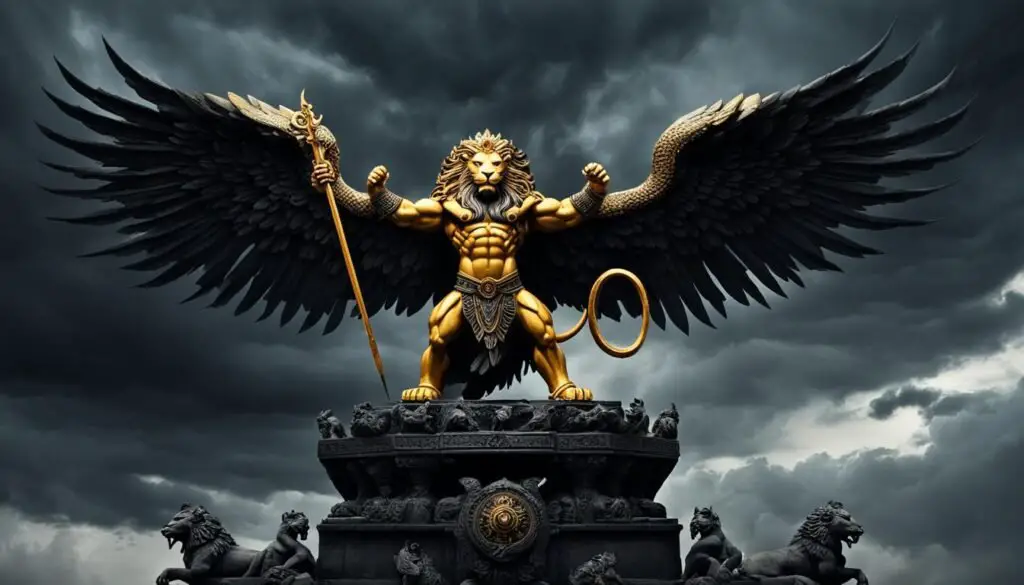
Exploring the key myths involving Seth and Nephthys allows us to better understand their divine essence and the eternal lessons they impart.
These myths serve as keystones that uphold the enduring legacy of this enigmatic pair in the annals of Egyptian culture.
Through tales of loyalty, betrayal, aid, and deceit, these myths provide insight into the intricacies of morality and familial ties in Egyptian mythology.
- The Betrayal of Osiris: In one of the most well-known myths, Seth’s jealousy and desire for power drive him to murder his brother Osiris, leading to a tale of loyalty and vengeance among the gods.
. - The Birth of Anubis: Nephthys, seeking solace from her loveless marriage to Seth, disguises herself as Isis and seduces Osiris. From their union, Anubis, the jackal-headed god of embalming and the afterlife, is born.
. - The Triumphant Horus: Throughout a series of conflicts and battles, Seth displays both loyalty and betrayal towards his nephew Horus, with their epic struggle for the throne embodying the eternal struggle between chaos and order.
These myths, along with many others, reveal the complex relationships and moral dilemmas that Seth and Nephthys navigate within the Egyptian pantheon. Their stories continue to captivate and inspire, shedding light on the profound beliefs and values of ancient Egypt.
The Symbolism and Iconography of Seth
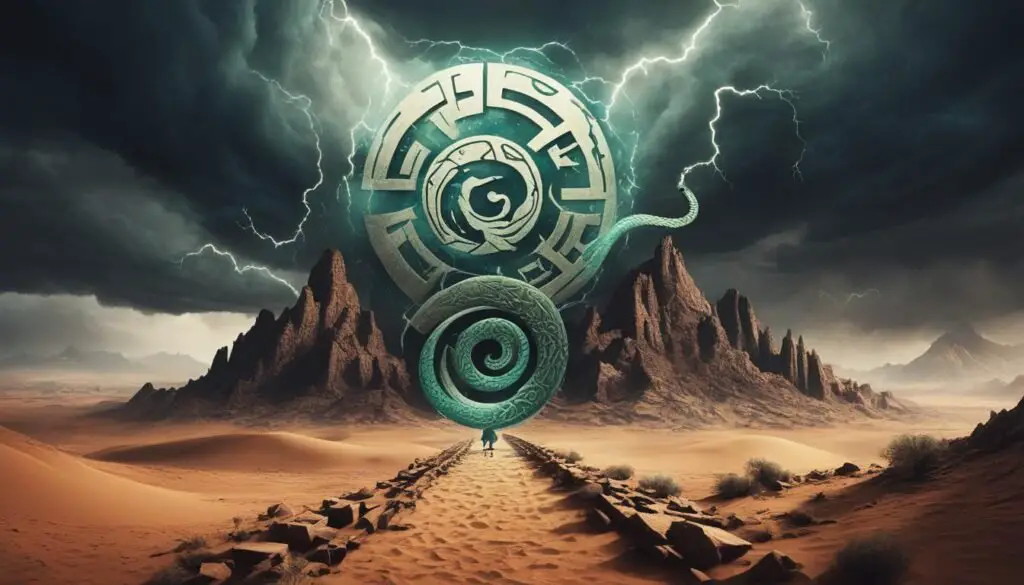
Seth’s symbolism and iconography are as complex and varied as his nature. Often depicted with a Canid-like head, Seth’s figure represents the necessary evil, the trials that lead to greater resilience, and the dualities of existence.
In ancient Egyptian art, Seth’s Canid-like head symbolizes his animalistic and unpredictable nature, evoking both fear and reverence.
This unique portrayal highlights his connection to chaos and the untamed forces of nature.
Seth’s dual nature is further emphasized through his role as both a creator and a destroyer. He is the embodiment of the trials humanity must face, representing the challenges that foster growth and resilience.
Throughout Egyptian mythology, Seth’s iconography serves as a reminder of the delicate balance between order and chaos.
His inclusion in religious rituals and ceremonies signifies the recognition of the necessity of disruptive forces in the cycle of life and rebirth.
Trials and Resilience: Lessons from Seth
- Seth’s trials and tribulations reflect the human experience, teaching us the importance of resilience in the face of adversity.
- His dualistic nature reminds us that life is a complex interplay between light and darkness, joy and sorrow.
- By embracing the challenges represented by Seth, we learn to overcome obstacles and find strength in our own transformative journeys.
As we delve further into Egyptian mythology, Seth’s symbolism and iconography continue to shape our understanding of the intricate tapestry of ancient beliefs.
Through his representation of chaos, trials, and resilience, Seth inspires us to navigate the eternal dance between order and chaos with courage and fortitude.
Conclusion
Seth, the enigmatic figure of Egyptian mythology, leaves an indelible mark on the landscape of ancient Egypt. As the god of chaos, Seth’s complex relationships, symbolism, and impact on myths continue to puzzle scholars and ignite the imagination of history enthusiasts around the world.
The enigma surrounding Seth invites us to delve deeper into the belief systems and cosmic balance cherished by the ancient Egyptians.
Unraveling Seth’s legacy and intricate narrative offers valuable insights into the complexities of Egyptian mythology. His representation of disruption and protection, exemplified by his role as the protector of Ra, illustrates the delicate dance between order and chaos in the ancient Egyptian worldview.
Seth’s enigmatic nature challenges us to explore the depths of his story, revealing profound truths about the human condition and our eternal struggle with duality.
By studying Seth’s impact in Egyptian mythology, we gain a deeper understanding of the cultural significance and religious beliefs of ancient Egypt. Seth’s enduring legacy prompts us to question the established norms and explore the boundaries of our own existence.
As we unlock the mysteries of Seth, we unearth profound wisdom that transcends time and reminds us of the eternal enigmas that shape our world.
Frequently Asked Questions
Q: What is the story of Seth the Egyptian god?
A: Seth is a prominent god in Egyptian mythology, often associated with chaos, deserts, storms, and war. He is known for murdering his brother Osiris and battling with his nephew Horus. Seth’s story symbolizes the struggle between order and chaos, good and evil.
Q: Is Seth and Anubis the same?
A: No, Seth and Anubis are not the same. Seth is the god of chaos and war, while Anubis is the god of mummification and the afterlife, often depicted as overseeing the weighing of the soul in the afterlife.
Q: What was Seth known for?
A: Seth was known for his role as the god of chaos, storms, and the desert. He was infamous for murdering his brother Osiris and his subsequent battles with his nephew Horus for the throne of Egypt.
Q: What are three facts about Seth?
A: 1. Seth was the god of chaos and disorder in Egyptian mythology. 2. He was married to the goddess Nephthys. 3. Seth was often depicted as a creature with a mysterious head, known as the “Seth animal,” which has no known parallel in the natural world.
Q: What did Osiris do to Seth?
A: Osiris did not do anything to Seth directly. It was Seth who murdered Osiris out of jealousy and desire for the throne. Osiris was later resurrected by his wife, Isis, and became the ruler of the underworld.
Q: What is the god Seth’s symbol?
A: Seth’s symbol is often known as the “Seth animal” or “Typhonic beast,” a creature with a curved snout, squared ears, forked tail, and canine body. The Was-scepter, a symbol of power, is also associated with him.
Q: What was Seth’s powers?
A: Seth possessed powers associated with chaos and storms. He had the ability to create storms and was believed to rule over the deserts and foreign lands. As a god of war, he was also seen as a protector of Ra, the sun god, from the serpent Apep.
Q: What is Seth’s secret name?
A: The concept of a “secret name” is common in Egyptian mythology, but Seth’s secret name is not explicitly mentioned in ancient texts. Secret names were believed to hold magical power and were kept hidden.
Q: What animal does Seth represent?
A: Seth is represented by a mythical creature known as the “Seth animal,” which seems to be a composite of several animals, possibly including a donkey, aardvark, and jackal.
Q: Why did Horus and Seth fight?
A: Horus and Seth fought for the throne of Egypt following the murder of Horus’s father, Osiris, by Seth. Their battle symbolized the fight between good and evil, order and chaos.
Q: What happened to Seth in Egypt?
A: In Egyptian mythology, the conflict between Seth and Horus was eventually resolved by the gods, who decided Horus was the rightful ruler. Seth’s role evolved over time, from an antagonist to a defender of the sun god, Ra.
Q: Did Seth get pregnant by Horus?
A: This is a reference to a complex myth where Seth and Horus engage in several contests and deceptions. In one episode, Seth attempts to dominate Horus but fails. Later, through a trick, Horus’s semen ends up in Seth, leading to the birth of the moon god, Thoth. This story is symbolic and reflects the complex and often contradictory nature of Egyptian mythology.


